Football is one of the most popular and interesting sports. While most of the top teams play in Europe, countries like Germany, Brazil, Spain and England, the largest soccer stadium in the world built in Asia... Here are the top 10 largest football stadiums in terms of spectator capacity. Data taken from StadiumDB.com stadium database and current as of June 2018.
10. Borg El-Arab Stadium ("Borg Al-Arab") - 86,000 people
 This stadium is located west of the Egyptian city of Alexandria, near the Mediterranean coast. It was built in 2007 by the Egyptian Armed Forces Corps of Engineers and includes both a football pitch and an athletic track around the pitch. As a result, Borg Al Arab can be used as a multi-purpose sports arena.
This stadium is located west of the Egyptian city of Alexandria, near the Mediterranean coast. It was built in 2007 by the Egyptian Armed Forces Corps of Engineers and includes both a football pitch and an athletic track around the pitch. As a result, Borg Al Arab can be used as a multi-purpose sports arena.
And the Egyptian national team plays in Cairo and does not use the country's largest stadium for their matches.
9. Bukit Jalil National Stadium ("Bukit Jalil Stadium") - 87 411 people
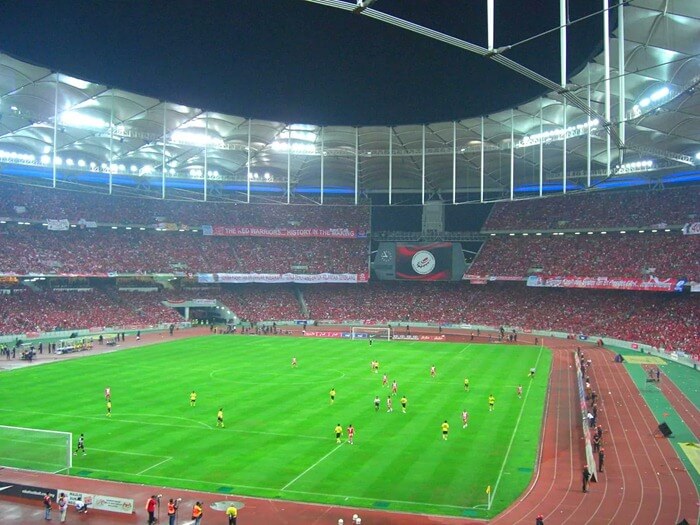 Although sometimes referred to as the “110,000-seat stadium,” it is actually much smaller. According to StadiumDB.com, Bukit Jalil accommodates just over 87,000 people. However, Malaysia's National Stadium, built on the outskirts of the capital, Kuala Lumpur, is the largest soccer stadium in the country.
Although sometimes referred to as the “110,000-seat stadium,” it is actually much smaller. According to StadiumDB.com, Bukit Jalil accommodates just over 87,000 people. However, Malaysia's National Stadium, built on the outskirts of the capital, Kuala Lumpur, is the largest soccer stadium in the country.
8. Wembley ("Wembley") - 90 652 people
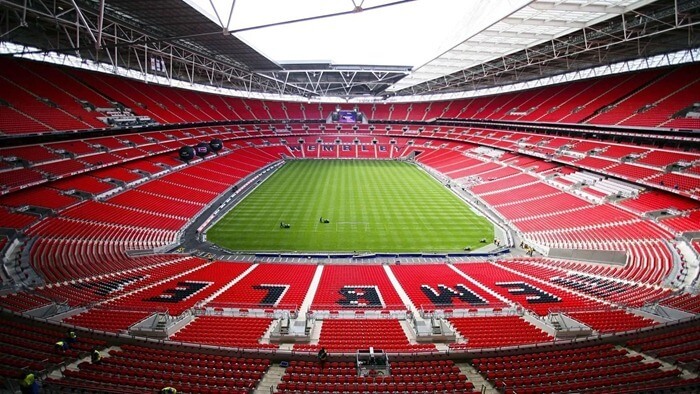 England's largest stadium was born in agony (2003-2007). First, it was built 4 years later than originally planned. Secondly, the cost of its construction amounted to 798 million pounds, and expected to spend half as much. Because of this, the general contractor and investors ended up in court, and many events had to be canceled.
England's largest stadium was born in agony (2003-2007). First, it was built 4 years later than originally planned. Secondly, the cost of its construction amounted to 798 million pounds, and expected to spend half as much. Because of this, the general contractor and investors ended up in court, and many events had to be canceled.
The stadium is in the shape of a bowl with a retractable roof, and the seats are divided into 3 tiers, the middle of which is exclusively for those with long-term reservations. This scheme is highly profitable, but has also received criticism from the media and fans. This approach divides loyal fans, making it difficult to create the right atmosphere.
The most characteristic feature of the stadium is, of course, the 133-meter steel arch, while the previous stadium had twin towers. At night, the arch lights up and is visible for many kilometers.
7. Bird’s Nest - 91,000 people
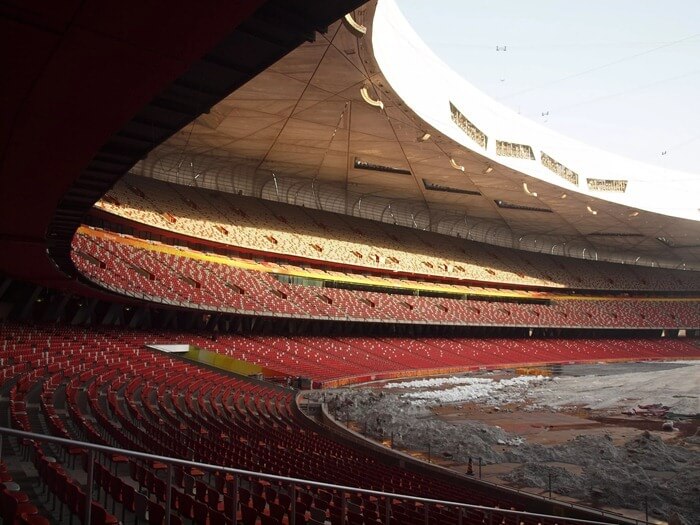 The National Stadium of China, built in Beijing for the 2008 Summer Olympics, will reopen its gates to the Olympians in the winter of 2022.
The National Stadium of China, built in Beijing for the 2008 Summer Olympics, will reopen its gates to the Olympians in the winter of 2022.
One of the largest football stadiums in the world was named "Bird's Nest" for a reason. It consists of a concrete bowl surrounded by 24 columns, and on top of them is an interweaving of giant steel beams. They resemble branches from which a huge bird's nest is built. And just like a nest, the structure of the stadium appears to be chaotic and at the same time very solid.As the cost began to rise rapidly, the organizers abandoned the retractable roof structure, which was originally intended to be made under the "nest".
6. Rose Bowl ("Rose Bowl") - 92,542 people
 The name of this American stadium comes from the Rose Bowl game, which is held here every year since January 1, 1923.
The name of this American stadium comes from the Rose Bowl game, which is held here every year since January 1, 1923.
The stadium was originally shaped like a horseshoe, but the open end of the horseshoe was closed by 1928. Until now, the bowl built at that time has remained practically unchanged; only minor additions or reconfigurations were made.
With its enormous size, the stadium in its best years (1972-1997) was able to accommodate over 104 thousand people. But due to the addition of seating, especially in the western and eastern zones, its size has decreased to 92,542 people.
5. Soccer City ("Soccer City") - 94 736 people
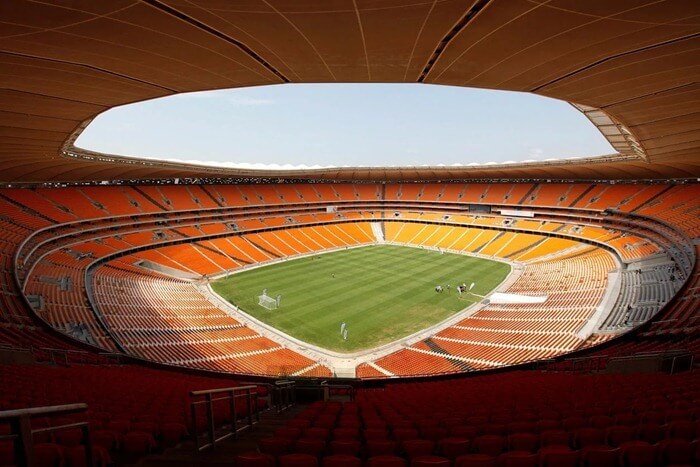 The FNB Stadium, also known by the more familiar name Soccer City, hosted the 2010 World Cup Final. Although its stands can accommodate 94,736 spectators, only 84,490 spectators were allowed into the stadium in 2010, with the remaining seats reserved for VIPs and the press. The stadium is located in one of the most dangerous cities in the world - Johannesburg, South Africa.
The FNB Stadium, also known by the more familiar name Soccer City, hosted the 2010 World Cup Final. Although its stands can accommodate 94,736 spectators, only 84,490 spectators were allowed into the stadium in 2010, with the remaining seats reserved for VIPs and the press. The stadium is located in one of the most dangerous cities in the world - Johannesburg, South Africa.
Due to its shape, which resembles an African pot or a local pumpkin, the stadium is nicknamed "Calabas".
4. Camp Nou ("Camp Nou") - 99 354 people
 The famous Barcelona club has the honor to play not only in Spain, but also at the largest football stadium in Europe. Construction began in 1954 and lasted three years. Three - also the number of architects who led the project - Francesc Mithans, Lorenzo Garcia Barbon, José Soteras Mauri.
The famous Barcelona club has the honor to play not only in Spain, but also at the largest football stadium in Europe. Construction began in 1954 and lasted three years. Three - also the number of architects who led the project - Francesc Mithans, Lorenzo Garcia Barbon, José Soteras Mauri.
From the outset, Camp Nou was an impressive building. The initial capacity of 90,000 spectators was increased to 110,000 in 1978 and then to nearly 120,000 in the lead-up to the 1982 World Cup. However, in the future, the safety rules of FIFA, UEFA and the national federation forced the management of the stadium to reduce the number of seats.
For decades, Camp Nou has been home to the World Cup, Olympic Games, Cup Winners' Cup, Champions League and many other major events.
3. Melbourne Cricket Ground ("Melbourne Cricket Ground") - 100,024 people
 The history of this Australian stadium, as the name suggests, is primarily associated with cricket. But it is also used for football tournaments (the first game took place in 1859), earning the status of the "spiritual home" of the Australian national team.
The history of this Australian stadium, as the name suggests, is primarily associated with cricket. But it is also used for football tournaments (the first game took place in 1859), earning the status of the "spiritual home" of the Australian national team.
Along with major cricket events (hosted 2 World Cups), the stadium is also the annual venue for the Australian Football Championship. In addition, the best European clubs sometimes use this stadium for their overseas tournaments.
2. Estadio Azteca (Azteca Stadium) - 105,000 people
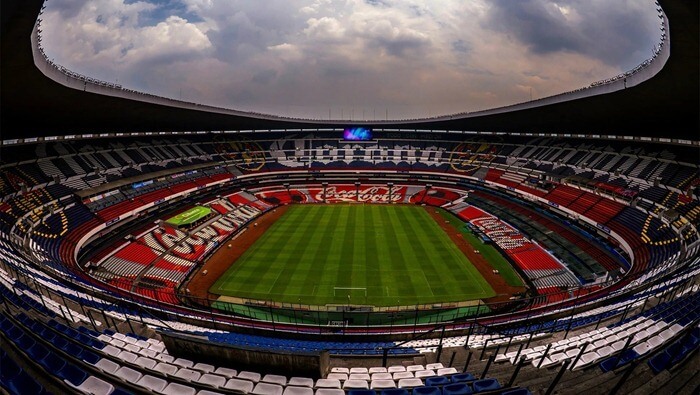 The second largest football stadium is located in the Mexican capital Mexico City. It boasts one of the largest premium areas with 856 private lodges for corporate clients. Interestingly, the stadium is neither public property nor the property of a sports club. Its owner is the Mexican media group Televisa.
The second largest football stadium is located in the Mexican capital Mexico City. It boasts one of the largest premium areas with 856 private lodges for corporate clients. Interestingly, the stadium is neither public property nor the property of a sports club. Its owner is the Mexican media group Televisa.
In 1986, football legend Diego Maradona scored one of the most famous goals, The Hand of God, in Argentina vs. England in the quarterfinals.
1. Rungrado May Day Stadium (Stadium named after May Day) - 150,000 people
 North Korea is not the most successful and wealthy country in the world. However, it has something that other countries do not yet have. This is the largest soccer stadium in the world. It is designed for 150 thousand spectators. The total area of the building is 207,000 m², and the height is 60 m.
North Korea is not the most successful and wealthy country in the world. However, it has something that other countries do not yet have. This is the largest soccer stadium in the world. It is designed for 150 thousand spectators. The total area of the building is 207,000 m², and the height is 60 m.
North Korea's National Stadium was built on May 1, 1989 in response to the construction of the Olympic Stadium in Seoul, as part of a rivalry between the two countries. The construction took 2.5 years, which is very fast for a building of this magnitude.
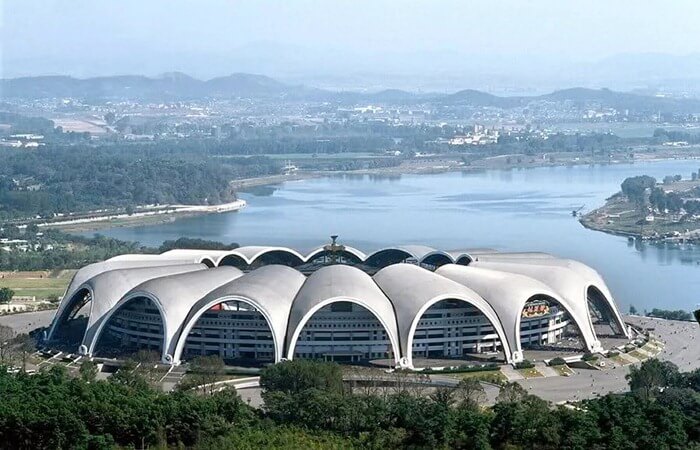 The most spectacular element of the stadium is its roof. It forms 16 petal-shaped segments that cover the stands and the 8-storey stadium building. In shape, it resembles a parachute or, in another symbolic connotation, a magnolia flower. The unique roof was recognized and awarded first prize at the 1988 Geneva International Exhibition of Inventions.
The most spectacular element of the stadium is its roof. It forms 16 petal-shaped segments that cover the stands and the 8-storey stadium building. In shape, it resembles a parachute or, in another symbolic connotation, a magnolia flower. The unique roof was recognized and awarded first prize at the 1988 Geneva International Exhibition of Inventions.
Due to its size, the stadium has seen many great events, setting the world attendance record in 1995. Then 190,000 spectators were accommodated in its stands.
When the North Korean football team is not on the field, massive celebrations are regularly held there. Also at the stadium in 1992, a public execution was held of generals who plotted to overthrow Kim Jong Il - the Sun of the Nation and the Father of the People (these are not all of his official titles).
The largest football stadium in Russia
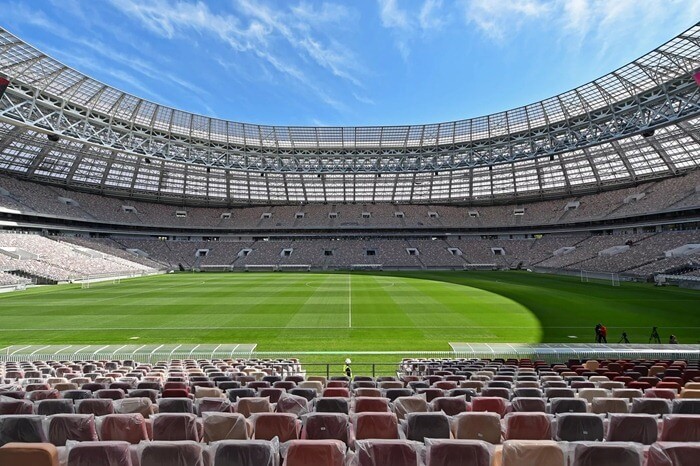 In Moscow, not far from Vorobyovy Gory, there is the Luzhniki stadium. Its stands can accommodate 81 thousand spectators. The 2018 FIFA World Cup will start there very soon (from June 14).
In Moscow, not far from Vorobyovy Gory, there is the Luzhniki stadium. Its stands can accommodate 81 thousand spectators. The 2018 FIFA World Cup will start there very soon (from June 14).

